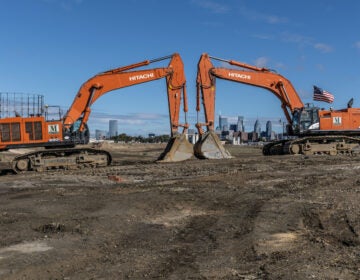A Q&A with New York City planner Howard Slatkin
On Jan. 8, Howard Slatkin, an expert in revisioning urban settings with the New York City Planning Commission, spoke at WHYY headquarters about the years-long process New York City used to reinvent and reinvigorate two miles of East River waterfront in Greenpoint-Williamsburg.
Given his depth of knowledge about the issues of scale of construction, affordable housing, public access and the establishment of parks and open spaces, PlanPhilly followed up his presentation by asking Slatkin to consider some best practices Philadelphia might consider as it re-imagines seven miles of Central Delaware Riverfront.
Q. What was your most visceral impression of the 7-mile stretch of waterfront we are dealing with?
A. My strongest impression was the size of the area – it covers such a wide variety of neighborhoods, uses, and physical conditions, which I imagine will demand a range of different solutions.
Q. Given what NYC did, what are the most important takeaways from your experience that we here in Philadelphia can use to make this process successful?
A. For a large and ambitious planning effort that depends heavily on private development, it’s important to achieve awareness and engagement from all elements of the community – residents and businesses as well as the development community. I think that building consensus on overall goals and acknowledging the need to balance among competing goals are important early steps. While people may disagree about how to achieve those goals, this type of collective understanding helps allow for a productive, problem-solving approach later in the process.
Q. Do you see casinos and I-95 as deal breakers in this process? What were your biggest impediments and how did you get past them? Work with them? Through them?
A. I’m really not well enough informed on the issue to comment on casinos in Philadelphia. As for highways near the waterfront, they need not be an insurmountable obstacle. In New York City, for instance, there are a number of neighborhoods where recent or planned developments respond successfully to highways and bridges near the waterfront – Riverside Park South, the East River Waterfront, DUMBO and Brooklyn Bridge Park, for instance.
Q. How did you all handle the politics that is imbedded in this type of planning process?
A. Politics is always an important consideration, of course. New York City’s land use review process includes clear roles for community boards, borough presidents, and City Council members. And under the current administration, there has been a strong focus on consensus building as a key to success. In Greenpoint-Williamsburg, we conducted an additional public outreach process that preceded this formal review, in order to ensure that we had engaged the community, elected officials, and other stakeholders in the development of the plan.
Q. And lastly, now that you have a sense of our challenges, what objective advice might you give us?
A. Especially for a planning effort of this scale, I think it’s important to focus both on the long and short term – to identify goals that are well considered, practical, and flexible enough to work in the long run, but also to identify strategic opportunities to achieve results in the near term, with real deadlines wherever possible – to make it clear that the plan will do more than look good sitting on a shelf.
WHYY is your source for fact-based, in-depth journalism and information. As a nonprofit organization, we rely on financial support from readers like you. Please give today.






